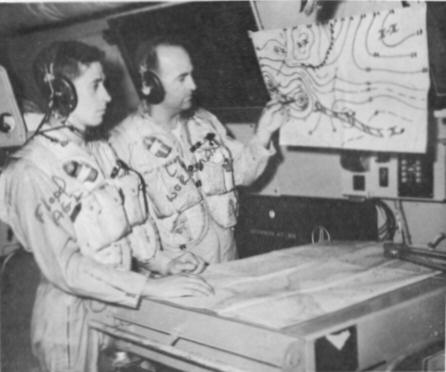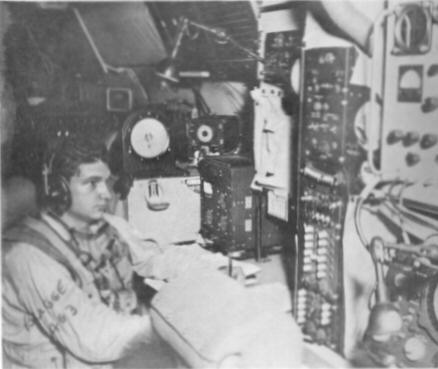the weather office
As directed by the Chief of Naval Operations, Commander Naval Air Forces, Pacific assigned AWERON ONE (VW-1) the primary task of airborne weather reconnaissance on July 1, 1961. In support of this new assignment, VW-1 set up a weather office and was assigned 7 officers and 17 enlisted men. The first requirement faced by the weather office was to prepare a training program, with airborne weather reconnaissance as its subject, for it weather personnel and put it to use. They also had to assure useful continuance of training programs in the months and years to come.
In addition to the above requirements, the weather office provides information concerning present and forecast weather conditions in the squadron's operating areas and within the air routes joining them with each other and, of course, with Guam; the weather office assists in the planning of all weather reconnaissance flights; the weather office is responsible for taking an communicating to the Joint Typhoon Warning Center located on Nimitz Hill all in flight weather observations; the weather office maintains a complete file of all weather reconnaissance records some of which are transferred to the National Weather Records Center in Ashville, North Carolina to provide valuable research information and permanent safe-keeping; finally, the weather office recommends the assignment of all weather personnel to weather reconnaissance flight crews.
As a squadron, AEWRON ONE is a unique n two respects. First, it is one of only two such squadrons in the United State Navy assigned weather reconnaissance as the primary mission; second, it is one of the few squadrons in the Armed Forces actually employed in its primary mission, in that other squadrons are usually assigned primary missions of combat in nature which cannot be fulfilled during the peacetime campaign, thus causing activities to train for combat or to carry out other tasks of a secondary nature. VW-1 is at war with weather, a war that know no peaceful solution. Only through adequate warning leading to efficient preparedness can civilization be assured minimum damage. VW-1 provides the adequate warning which makes these preparations possible to save lives and minimize property damage.
Before relating the story of VW-1's first typhoon season and the details of how the squadron performs this job, a breakdown of tropical disturbances will follow. the typhoon season begins in June and continues through November each year, however, it is not uncommon for these tropical disturbances to occur during the "off season" months. Tropical disturbances have three classifications: (1) The Tropical Depression is a tropical cyclone in which the maximum surface wids are less than 34 knots; (2) The Tropical Storm is a tropical cyclone in which the maximum surface wind are no more then 63 knots but 34 or more, and (3) The Typhoon is a tropical cyclone in which the maximum surface winds exceed 63 knots. these storms are also referred to as Hurricanes, Baguios, and Willy Willies in other parts of the world.
The average monthly frequency of these tropical cyclones is as follows: From January through April the average is less then one a month, May and June the average is one a month,, from July through October the average becomes three to four a month and the average for November is two. December's average is one. In 1959, 18 tropical cyclones became typhoons; in 1960, 21 tropical cyclones became typhoons; and, in 1961, 69 tropical cyclones were recorded, of which 19 became typhoons, 9 became tropical storms and 37 were classified as tropical depressions.
The squadron's first typhoon season, July 1, 1961 to December 31, 1961, was a huge success. VW-1 fulfilled all of the 114 weather missions requested by the Joint Typhoon Warning Center, Guam. In fulfilling these missions, 853.5 flight hours were compiled in 107 flights making 118 actual fixes. these flight were made on all categories of tropical cyclones, that is to say from flying investigation flights on areas of suspected disturbance to actually penetrating a typhoon to obtain a fix. Some of these typhoons packed center surface winds in excess of 100 knots.
VW-1 received its first assignment on July 1, 1961 thus commencing its newly assigned mission with no delay. The first typhoon fixed after July 1, 1961 was "Elsie" on the 13th day of July. This typhoon had center winds in excess of 80 knots. From "Elsie" the squadron went on to fix 14 more typhoons, 3 tropical storms and approximately 25 other tropical disturbances. The last flight of the 1961 was made on typhoon "Ellen" on the 13th of December 1961. The longest single reconnaissance flight of the season came about on the 15th of November. Eighteen point one flight hours were flown, excluding 1 hour ground time for refueling, making two fixes on typhoon "Dot" near Wake Island.
VW-1's area of responsibility is wide, covering the entire area of the Pacific west of the International Date-Line and north of the Equator, including the south China Sea. To cover this wide area, the squadron utilized four bases of operation excluding, of course, Guam. The four operating bases were: NAS Atsugi, Japan; NAF Naha, Okinawa; NS Sangley Point, Luzon, Philippines; and FAA Wake Island.
AEWRON ONE's successful season is noted by the letter of appreciation it received from various parent activities. The first appreciation to be noted came on the 20th of September 1961 from the Joint Typhoon Warning Center, which stated in part, "From standpoint this command, operational and scientific performance of VW-1 outstanding in all respects and in accordance withe the highest traditions of the Naval Service". On the 19th of January 1962 a w"well done" was received from the Commander in Chief, Pacific Fleet. The Commander Seventh Fleet stated, "Request you pass to all officers and men of your command my personal thanks for a long, tedious and difficult job. Very well done". Finally, and certainly not least, was the following message received from the Chief of Naval Operations, "The outstanding performance of VW-1 during the 1961 typhoon season is noted with pleasure, Well done George W. ANDERSON".
A weather reconnaissance mission actually consists of three steps: (1) pre-flight; (2) in-flight; and (3) post-flight. Pre-flight begins approximately two hours before the actual takeoff time, which is established according to the time the fix is requested by JTWC and the distance to the storm. the pre-flight consists of assuring the safety of the aircraft for the aircraft for the flight and preparations are made by the weather personnel to assure that all weather instruments are in operating order. The weather officer assists the pilot and navigator in planning for the flight and recommends procedures to be taken to fix the storm.
The second step, in-flight, is the actual weather reconnaissance flight and fixing of the storm. The weather personnel begin immediately to transmit weather information back the JTWC. This information consists of cloud structures, surface winds, visibility, temperature, relative humidity and all other weather information observed. At the proper time, the actual storm is located and plotted geographically and its position sent to JTWC. Along with the actual position of the storm, information concerning its size and movement are sent, and if penetration is made all weather information mentioned above is obtained and sent with the position. Having fixed the storm the aircraft heads for its destination.
Post-flight consist of first, the weather officer calling JTWC and assuring JTWC that all information concerning the storm is in their possession. He then writes out a post-flight summary for filing in the weather office. The senior enlisted weatherman gathers all records made on the flight and assures their proper filing in the weather office.
cic division
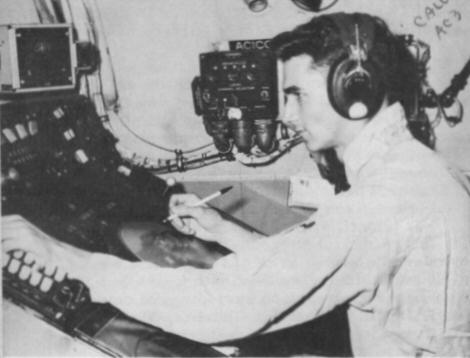
The CIC Division is an integral part of the Operations Department with AEWRON ONE. It's function is twofold: to train personnel in their responsibilities for Airborne Early Warning. and to collect and evaluate information obtained from barrier operations and typhoon reconnaissance.
It is the duty of the CIC Officer, assisted by his staff, to supervise and coordinate the flow of AEW information between operational departments of the squadron and the 7th Fleet activities. To do this, it is necessary to maintain current CIC logs and assist in the development of operation plans and orders. The CIC Division must work closely with the Aerology Division to help perform the primary mission of the squadron, which is typhoon reconnaissance.
the flight office
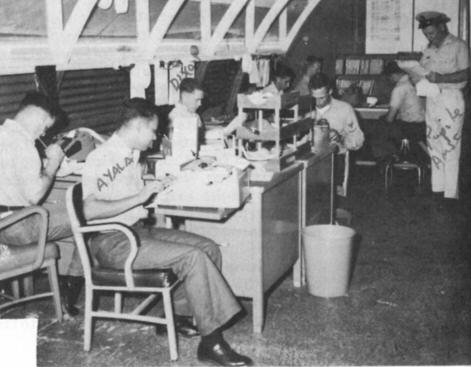
The Flight Office is the admisistrative and coordinating division of the operations department. The men in this office perform clerical nad record-keeping tasks, which are required of the squadron.
The Flight Office also prepares the daily flight schedule, coordinates aircraft maintenance and repair, and schedules operational and training flights in accordance with the aircraft availability.
Crew assignments are made in this office too, an here is where the plans for the deployment of squadron ircraft are formed. Last, but certainly not least, the Flight Office is responsible for the administration of flight pay.
air intelligence
The primary responsibility of the Air Intelligence Office is to insure that the Commanding Officer is constantly informed of all Intelligence matters which may effect decisions on the command level. This involves the accumulation of pertinent information, evaluation of its bearing on squadron operations, and dissemination of such information to the proper personnel.
The Air Intelligence Officer also provides staff services to the Commanding Officer and acts as a special assistance to the Operation Officer, aiming in the coordination of deployment plans and briefing necessary personnel on deployment operations.
communications division
The VW-1 communications Office is the "HUB" of all squadron messages, classified and unclassified. all messages addressed to the squadron are first sent to this office. They, in turn, distribute the traffic to squadron personnel on a "need to know" basis, from the Commanding Officer on down to the newest recruit, if the message also affects him.
At the present time the office has two officers in charge, one designated Communications Officer and the other Assistant Communications Officer. The office also has an enlisted supervisor. The other people in the office are primarily AG's, numbering five, and two non-designated airmen.
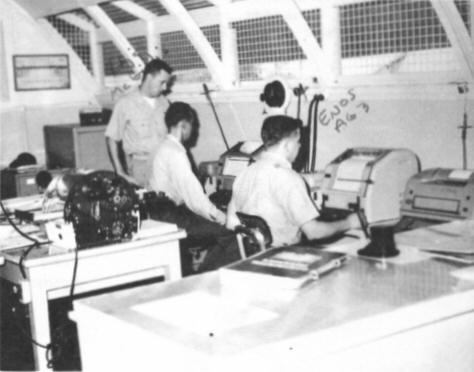
Their watches are set up on a mid, eve,day basis. The stand three of each of these watches and then are granted time off.
In addition to handling classified and unclassified message traffic. the Communications office also has secondary duties. All of the radiomen on VW-1 aircraft are responsible to turn in their logs to this office, where they are filed. The office also handles all phone requests, removals, and relocations.
Last, but no least, the office is responsible for the plotting of all aircraft on transpacs and weather missions. The aircraft send position reports every hour and these are plotted so that all squadron personnel can see where their planes are. There is also a plot kept of all weather missions. The weather messages come over the teletype in code which broken down by the AG's and then put on the board. This way, you can readily tell what type of weather the aircraft are encountering.
To sum things up, the Communications office, as mentioned earlier, is the "HUB" of the squadron, with the spokes being the various office spaces. Its job is extremely important to the smooth operation of the squadron and "SECURITY CONSCIOUNESS" is utmost in the minds of all.
navigation
The Navigation Office has the responsibility of ordering, and supplying the Pilots and Navigators with the charts, sextants, chronometers, and other gear needed to navigational purposes during the course of a flight.
A local area Notice to Airmen, (NOTAM) board is kept, along with a chart showing restricted areas an warning areas in the operational areas.
training division
The Training Officer and his assistants supervise the training of squadron flight personnel in their qualifications for crew members. This training is not only for pilots, it is training for all members, engineers, radiomen, etc.
Certain qualifications are required for all crew members. Some of these are:
Flight training is supervised here. Our instructors are the Plane Commanders of the squadron. who are responsible for the standardizing and upgrading pilots from Third Pilot, Second Pilot to the Plane Commander designation. Training is a continuous operation for all hands.

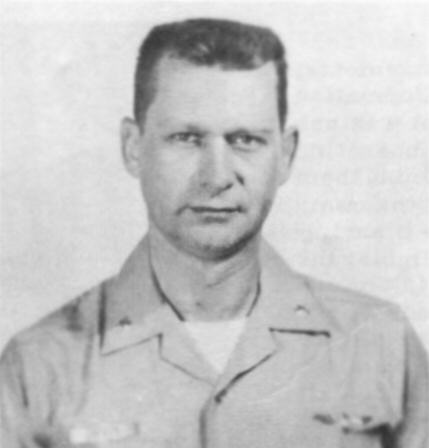 COMMANDER JOHN B. SHERFY, JR.
COMMANDER JOHN B. SHERFY, JR.